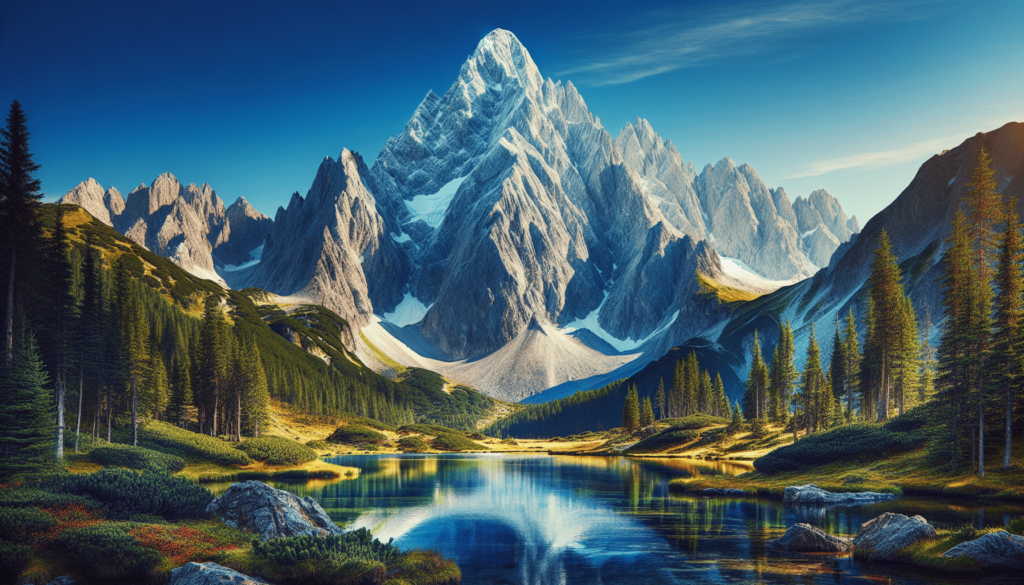Your cart is currently empty!
Exploring the Majestic Mountain Peaks

Have you ever looked up at a mountain and felt a sense of wonder? The majestic peaks that rise high into the sky can spark your imagination and inspire a spirit of adventure. Let’s journey through the world of mountains, from their formation and ecology to the best ways to experience their beauty.

Understanding Mountain Formation
Did you know that mountains are formed through a variety of geological processes? Their creation is often a result of the earth’s crust interacting through tectonic forces.
Tectonic Plate Movements
At the heart of mountain formation are tectonic plates. The Earth’s surface is divided into large sections called plates, which fit together like a jigsaw puzzle. When these plates collide, they push against each other, creating immense pressure that forms mountains.
- Convergent Boundaries: Where two tectonic plates move towards each other, you’ll often see mountain ranges being uplifted.
- Divergent Boundaries: Here, plates pull apart, leading to the formation of new crust, and can also contribute to mountain chain creation, particularly underwater.
Erosion and Weathering
Once mountains are formed, they undergo continuous change due to erosion and weathering. Wind, rain, and ice wear down the peaks over time. This process not only shapes the mountains but also contributes to the unique landscapes you might see today.
The Ecology of Mountain Regions
Mountains are often referred to as “biological treasures” because they support diverse ecosystems. You might be surprised to learn how different each elevation can be.
Vertical Zonation
As you ascend a mountain, the climate and flora change significantly. This phenomenon is known as vertical zonation.
-
Lower Elevations: Characterized by lush forests, these areas often teem with wildlife.
-
Mid-Elevations: You’ll find more scrub-like vegetation and a variety of animal species adapted to thinner air and cooler temperatures.
-
High Elevations: Above a certain altitude, known as the tree-line, conditions become harsher. The flora is minimal, with hardy species such as mosses and lichens making their home here.
Adaptations of Mountain Flora and Fauna
The inhabitants of mountain ecosystems have developed unique adaptations to survive. For instance:
| Species | Adaptation |
|---|---|
| Mountain Goat | Thick fur and specialized hooves for steep terrains |
| Himalayan Blue Poppy | Deep roots to withstand high winds and cold |
| Snow Leopard | Camouflaged fur to blend in with rocky environments |
You can see how life thrives in challenging conditions, which makes mountain ecosystems fascinating.
The Cultural Significance of Mountains
Mountains are not just natural wonders; they also hold cultural and spiritual significance for many communities around the world.
Sacred Peaks
In various cultures, mountains are revered as sacred spaces. For example:
- Mount Fuji in Japan is a symbol of beauty and spirituality. It’s not uncommon for locals and visitors alike to seek inspiration in its majestic form.
- The Himalayas are considered sacred in Hinduism and Buddhism, seen as the abode of the gods.
Economic Importance
Beyond their spiritual significance, mountains also play an important role in local economies.
- Tourism: Many people travel to mountains for skiing, hiking, or climbing, generating significant revenue for local communities.
- Natural Resources: Mountains often host deposits of minerals and other resources, which can be harvested for economic gain.
Adventure Awaits: Activities in the Mountains
If you’re looking for adventure, mountains offer a range of activities that allow you to connect with nature.
Hiking
Hiking is one of the most popular activities. Whether you’re a beginner or an experienced hiker, you can find trails that suit your skill level.
-
Beginner Trails: These often have well-marked paths and gentle slopes.
-
Advanced Trails: These might involve rocky terrains and steeper inclines, perfect for seasoned adventurers.
Climbing
For those who seek a physical challenge, mountaineering and rock climbing can be exhilarating experiences.
-
Technical Climbing: This involves using specialized equipment to ascend steep, rocky outcrops.
-
Ice Climbing: Quite demanding, it requires tools like ice axes and crampons to climb frozen waterfalls or glaciers.
Skiing and Snowboarding
If you find yourself in the mountains during winter, skiing and snowboarding are must-try activities.
-
Ski Resorts: These often provide amenities like chair lifts, rental equipment, and lessons for beginners.
-
Backcountry Skiing: For the more adventurous, this takes you away from the groomed slopes into uncharted territories.

Planning Your Mountain Trip
Before heading off on a mountain adventure, it’s essential to prepare and plan accordingly.
Choosing the Right Destination
There are countless mountain ranges around the world. Here are a few to consider based on what you seek:
| Mountain Range | Activities | Best Time to Visit |
|---|---|---|
| Rockies (USA/Canada) | Hiking, skiing, wildlife tours | June to September |
| Andes (South America) | Trekking, cultural exploration | May to October |
| Alps (Europe) | Skiing, mountaineering | December to March |
Gear Up
Packing the right gear is crucial for safety and comfort. Make a checklist that includes:
- Clothing: Layered clothing is essential. It allows you to adapt to changing temperatures.
- Footwear: Sturdy hiking boots will support your ankles and provide grip.
- Navigation Tools: A map, compass, or GPS device can prevent you from getting lost.
Safety Precautions
Mountains can be unpredictable, so take some precautions to ensure a safe trip.
- Weather Check: Always check the weather forecast before setting off. Conditions can change rapidly in mountainous areas.
- Buddy System: If possible, travel with a friend or group. This way, you’ll have support in case of emergencies.
The Wilderness Experience
There’s something incredibly rewarding about immersing yourself in nature, and mountains provide a perfect backdrop for that experience.
Camping
Spending a night under the stars can be a memorable adventure.
- Campsites: Many mountains have designated campsites equipped with facilities.
- Backpacking: For a more isolated experience, consider backpacking where you set up camp away from established sites.
Photography
If you enjoy capturing moments, mountain landscapes can provide breathtaking views.
- Golden Hour: The hour after sunrise and before sunset presents the best light for photography.
- Wildlife: Keep an eye out for animals, as they can make stunning subjects.
Respecting the Environment
As you enjoy your time in the mountains, remember to respect the natural environment.
Leave No Trace Principles
These guidelines can help you minimize your impact:
- Plan Ahead: Choose your routes wisely.
- Stay on Trails: This helps to prevent erosion.
- Pack Out What You Pack In: Bring back your trash to keep nature clean.
Wildlife Etiquette
While observing wildlife can be exciting, maintaining a respectful distance is crucial.
- Do Not Feed Animals: Feeding wildlife can disrupt their natural behavior.
- Use Binoculars: Observing from afar is safer for both you and the animals.
Sustainable Mountain Tourism
The concept of sustainable tourism is becoming increasingly important in mountain regions.
Eco-friendly Practices
If you want to contribute positively while visiting, consider these eco-friendly practices:
- Support Local Businesses: Choose local guides, accommodations, and products.
- Offset Your Carbon Footprint: Consider carbon offset programs if you’re traveling far.
Engaging with Local Communities
Learning from local cultures not only enriches your experience but also helps promote the well-being of those communities.
- Participate in Local Events: Engaging in cultural experiences can offer insights into the community’s relationship with the mountains.
- Volunteer: Many organizations work on conservation efforts, and joining them can be a fulfilling way to give back.
Conclusion
Mountains are a captivating wonder that offer breathtaking beauty and adventure. From their awe-inspiring formations and diverse ecosystems to the thrill of outdoor activities, they promise an unforgettable experience.
Whether you’re hiking up a familiar trail or discovering a new peak, the mountains invite you to take a break from your daily routine and reconnect with nature. So why not lace up your boots and see where your next adventure takes you?